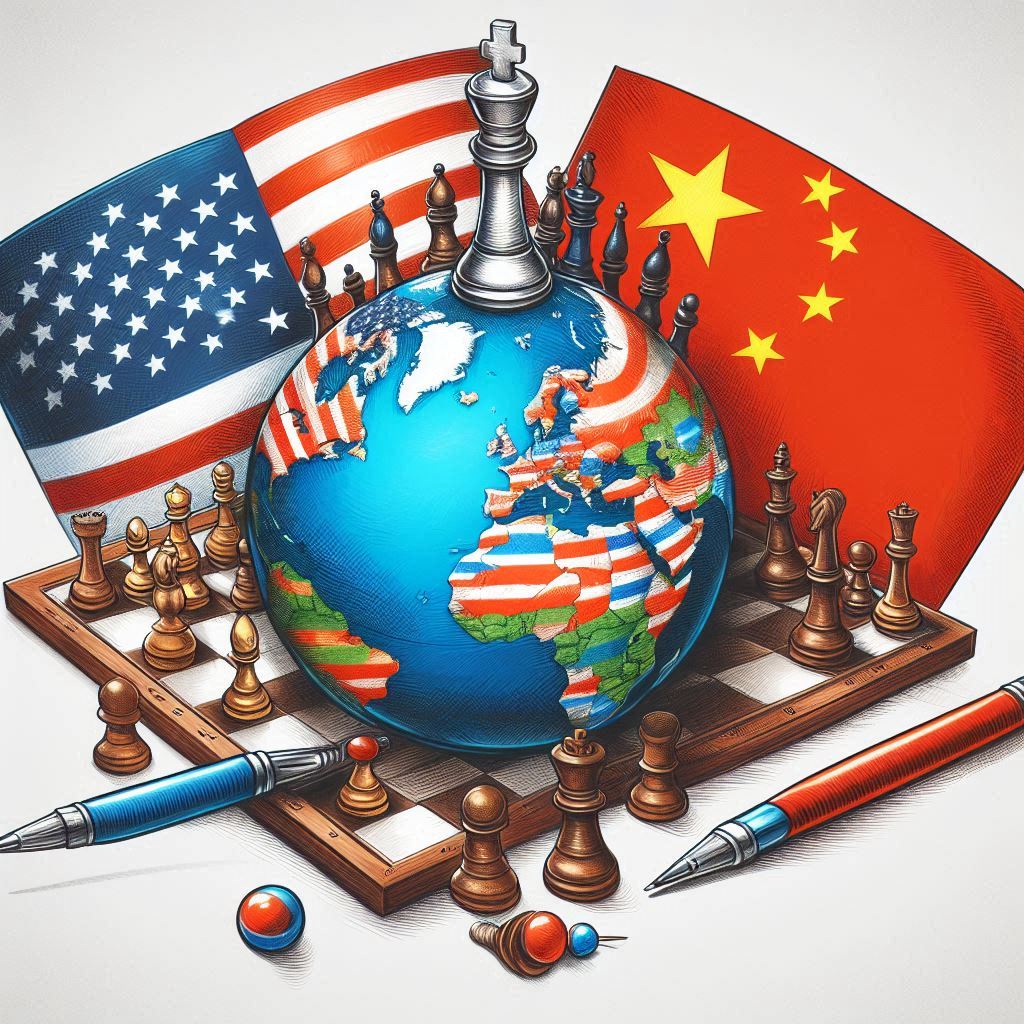
Category: Russia
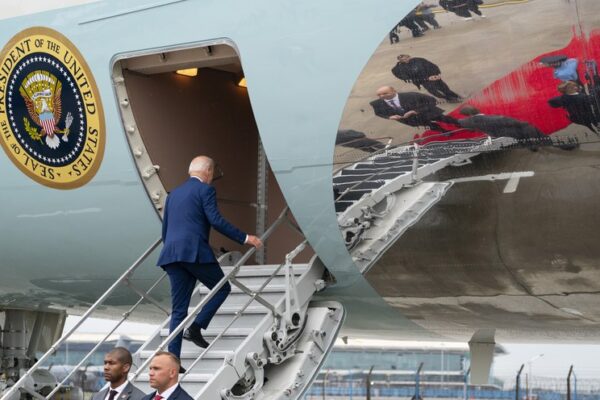
G20 ends on high note for Indian host
The G20 wound up on Sunday with leaders visiting a memorial statue to Indian independence leader Mahatma Gandhi, a day after adding 55 new member states via the African Union and coming up with a compromise communique soft on Russia’s invasion of Ukraine. Prime Minister Narendra Modi invited the African Union to join the G20 as a permanent member on Saturday in his opening remarks, calling on members to end a “global trust deficit.” “It is time for all of us to move together,” Modi said. Despite widespread anticipation that this year’s summit would be a damp squib, it appeared to have featured some significant pushback on China’s apparent unwillingness to play ball with the developed world. Modi announced on Saturday that negotiators had resolved deep differences over the wording on the war in Ukraine, but the phrasing – not invasion by Russia but “war in Ukraine” – was clearly a bone to Russia and China, whose leaders did not attend. China and Russia were opposed to any joint statement that censures Russia’s invasion of Ukraine. U.S. President Joe Biden skipped the final session of the summit, heading to Vietnam, where a Whitehouse official said the two nations would elevate their relationship to a comprehensive strategic partnership, putting it on a par with Beijing and Moscow’s engagement with Hanoi. U.S. President Joe Biden leaves for Vietnam after attending the G20 Summit, in New Delhi, India, Sunday, Sept. 10, 2023. Credit: AP Modi pronounced the summit a success. “On the back of the hard work of all the teams, we have received consensus on the G20 Leaders Summit Declaration. I announce the adoption of this declaration,” Modi told the G20 leaders in New Delhi. “#G20India has been the MOST ambitious in the history of #G20 presidencies. With 112 outcomes and presidency documents, we have more than tripled the substantive work from previous presidencies,” said India’s G20 Sherpa representative Amitabh Kant on social media. Commentators said that it was significant that India appeared to be ready to take a more assertive role in global politics. Modi ended the summit by passing on the ceremonial gavel to Brazil’s president Luiz Inacio Lula da Silva, whose country takes over the bloc’s presidency. Welcome Africa The announcement of permanent inclusion of the 55-nation African Union (AU) is likely to be a blow for Chinese president Xi Jinping, who did not attend the summit for unknown reasons, and recently heralded the new membership of six countries in the BRICS grouping as “historic.” The AU’s young population of 1.3 billion is expected to double by 2050, when it will account for a quarter of the global population. It’s strategically important to both China, Africa’s largest trading partner and one of its largest lenders, and Russia, its leading arms provider. Indian Prime Minister Narendra Modi, right, shares a light moment with African Union Chairman Azali Assoumani upon his arrival at Bharat Mandapam convention center for the G20 Summit in New Delhi, India, Saturday, Sept. 9, 2023. Credit: Pool via Reuters Meanwhile, in what will likely be seen as a challenge to Xi’s ambitious Belt and Road Initiative (BRI), U.S. President Joe Biden, Modi and allies announced a rail and shipping corridor connecting India with the Middle East and ultimately Europe. The project will include the United States, India, Saudi Arabia, the United Arab Emirates, the European Union and other countries in the G20. Commentators speculate it will enable greater trade and be an ambitious counter to China’s massive BRI, through which it has sought to invest and lend its way to making its economy better connected with the world. Saudi Arabian Crown Prince Mohammed bin Salman, left, and Indian Prime Minister Narendra Modi shake hands next to U.S. President Joe Biden on the first day of the G20 summit in New Delhi, India, Sept. 9, 2023. Credit: AP/POOL The moves on Saturday, which were roundly seen as pushback against China, came against a background of speculation as to why China’s Xi was not present and calls for Beijing to explain itself. “It’s incumbent upon the Chinese government to explain” why its leader “would or would not participate,” Jon Finer, the U.S. deputy national security adviser, told reporters in Delhi. He said there was speculation that China is “giving up on G20” in favor of groupings like BRICS, where it is dominant. Chinese Premier Li Qiang, who attended the summit as a representative of Xi, called on the European Union Commission President Ursula von der Leyen for greater unity and cooperation between the two sides to counter global uncertainties, according to a statement on Sunday from China’s Ministry of Foreign Affairs. Li urged the EU to provide a non-discriminatory environment for Chinese companies, as the bloc becomes warier of the risks of engaging China, seeing it as a “systemic rival” since 2019. Edited by Mike Firn and Elaine Chan.
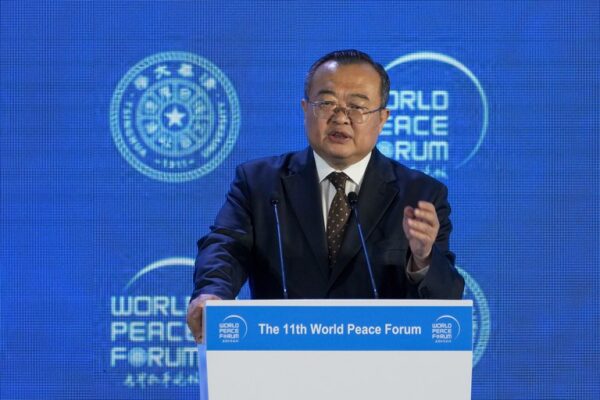
Vietnam wants it all in balancing its ties with the US and China
President Joe Biden is heading to Vietnam for a visit that will upgrade bilateral relations to a “strategic comprehensive partnership,” a symbolic step that opens the door to wider cooperation between former Cold War foes who are now grappling with an assertive, powerful China. The elevated status is a symbolic gesture that recognizes the developed state of U.S.-Vietnam ties, almost 30 years after they normalized diplomatic relations and a half century since the end of the Vietnam War. But it doesn’t reflect a fundamental change in Vietnamese policy. Indeed, it should be seen as a manifestation of what Hanoi calls its omnidirectional and independent foreign policy. The overall growth of the relationship will remain hemmed in by the fact that the communist leaders who run Vietnam share the same world view as those who control China. In a partnership hierarchy created by the Vietnamese government, at the very top are neighbors Laos and Cambodia. However, what was once Vietnam’s secure western flank is now a source of concern with China’s surge in influence through investment, lending, development projects, and corruption. Comprehensive strategic partnerships had been reserved for Vietnam’s friends since the days of the revolution: Russia, China, and India. In 2023, in recognition of their burgeoning economic relationship, Vietnam elevated South Korea to that pantheon, recently followed by Singapore and Australia, and soon Indonesia. Liu Jianchao [shown], the head of the Communist Party of China’s International Liaison Department, recently met with General Secretary of Communist Party of Vietnam, Nguyen Phu Trong. Credit: Andy Wong/AP file photo For the U.S., the leapfrog from Vietnam’s comprehensive partner to a comprehensive strategic partner is important for three reasons. First, for top leaders in Hanoi, symbolism does matter. That a former foe is now on a par with revolutionary era friends is a win. Second, this upgrade will not please China, even though Hanoi has worked assiduously to try to convince Beijing that it is maintaining its independent foreign policy. It is inconceivable that Hanoi has not briefed Beijing on this, and Communist Party of Vietnam General Secretary Nguyen Phu Trong has made party-to-party ties stronger than ever. He would not have approved the relationship upgrade if he felt insecure by Beijing’s reaction. Five days before Biden’s expected arrival this weekend, Liu Jianchao, the head of the Chinese Communist Party’s International Liaison Department met with Trong, who no doubt gave him further assurances. While Washington may want to rankle Beijing, which has overplayed its hand in the region with its aggressive South China Sea behavior and hawkish “Wolf Warrior” diplomacy, its real goal is to see Vietnam be strong enough to assert its vaunted autonomous foreign policy. Hanoi will no doubt be sending a politburo-level delegation to assure Beijing that the upgrade is not a lurch towards the United States or in any way anti-Chinese, but a manifestation of Vietnam’s independent and omni-directional foreign policy. Third, at the bureaucratic level, it’s hoped that the upgrade gives political top cover for the line ministries to increase their cooperation with U.S. counterparts across a range of issues, from countering narcotics and human trafficking to security cooperation. The upgrade does not automatically lead to more market access, more trade and investment, more port visits and other military engagements, but it won’t hurt their prospects either. In short, this upgrade is long overdue, and reflects the fact that the U.S. has far deeper ties than many other states ranked above it. An economic imperative The upgrade comes as Vietnam’s economy is slowing dramatically. Despite 8.5% growth in 2022, GDP only grew by 3.72% in the first six months of 2023, half the target. The Asian Development Bank and IMF have lowered their annual forecasts to 5.8% and 4.7%, respectively. While Vietnam has benefitted from corporate supply chain diversification out of China, that trend has also made the economy over-dependent on exports, which have fallen for five consecutive months, the longest slump in 14 years. In July, exports fell 3.5%. Industrial production contracted 1.8% in the first half of 2023, causing a 13% year-on-year increase in industrial layoffs. While Vietnam enjoys a large trade surplus with the U.S. – $44.3 billion in the first seven months of 2023 – that is down 24% year-on-year. Vietnam runs enormous trade deficits with China, as its manufactured goods are highly dependent on imported Chinese components. Without its exports to the U.S., Vietnam would run chronic trade deficits. As a direct foreign investor, the U.S. lags behind South Korea, Singapore, China, and Japan. In early 2023, Boeing announced a production facility, while Apple shifted an iPad production line out of China to Vietnam. But there’s plenty of room for growth. We should also not lose sight of portfolio investment from the U.S., where one fund alone has invested $1.5 billion in six projects. An employee works at Heesung Electronics Vietnam factory in Hai Phong, Vietnam, Aug. 29, 2023. Vietnam’s economy is slowing, with GDP growth of only 3.72% in the first six months of 2023. Credit: Nhac Nguyen/AFP Corporate Vietnam is trying to make a splash in the U.S.. Electric vehicle maker VinFast broke ground on a $4 billion plant in North Carolina, and has seen wild stock valuations after its recent listing on NASDAQ. VinFast sees the United States as the key to its growth, if not viability, despite a rocky first nine months that saw few sales and a recall. The tech firm VNG, Vietnam’s first “unicorn,” has filed paperwork for its listing on NASDAQ. If Vietnam is to escape the middle-income trap, it’s through trade and investment ties with the U.S., not China. To that end, executives from a swath of U.S. semiconductor and other tech industry will be joining Biden’s trip. What remains missing in U.S. policy towards the Asia-Pacific is an economic architecture. Since the withdrawal from the Trans-Pacific Partnership in January 2017, the United States has abdicated its leadership. States are going along with the Indo-Pacific Economic Framework for Prosperity (IPEF) , but only to keep Washington…
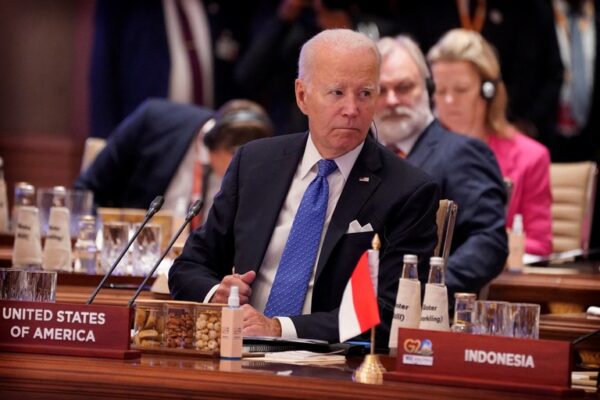
African Union joins G20 as compromise statement agreed
Prime Minister Narendra Modi invited the African Union to join the G20 as a permanent member on Saturday in his opening remarks, calling on members to end a “global trust deficit.” “It is time for all of us to move together,” Modi said. Modi announced later in the day during the summit that negotiators had resolved deep differences over the wording on the war in Ukraine. “On the back of the hard work of all the teams, we have received consensus on the G20 Leaders Summit Declaration. I announce the adoption of this declaration,” Modi told the G20 leaders in New Delhi. China and Russia are known to be opposed to any joint statement that censures Russia’s invasion of Ukraine. Despite widespread anticipation that this year’s summit would be a damp squib – perhaps resulting in no communique at all – the G20 appeared to be pushing back on China’s apparent lack of willingness to play ball with the developed world. The announcement of permanent inclusion of the 55-nation African Union (AU) is likely to be a blow for Chinese president Xi Jinping, who is not attending the summit for unknown reasons, and recently heralded the new membership of six countries in the BRICS grouping as “historic.” The AU’s young population of 1.3 billion is expected to double by 2050, when it will account for a quarter of the global population. It’s strategically important to both China, Africa’s largest trading partner and one of its largest lenders, and Russia, its leading arms provider. U.S. President Joe Biden listens to the opening remarks of Indian Prime Minister Narendra Modi during the first session of the G20 Summit, in New Delhi, India, Saturday, Sept. 9, 2023. Credit: Evan Vucci/Pool via Reuters Meanwhile, in what will likely be seen as a challenge to Xi’s ambitious Belt and Road Initiative (BRI), U.S. President Joe Biden, Modi and allies were reported to have plans to announce a rail and shipping corridor connecting India with the Middle East and ultimately Europe. The project would include the United States, India, Saudi Arabia, the United Arab Emirates, the European Union and other countries in the G20, the Associated Press reported Jon Finer, Biden’s principal deputy national security adviser, as saying. Biden, Modi and European Commission President Ursula von der Leyen were to announce the project as part of the Partnership for Global Infrastructure Investment, with commentary speculating that it would enable greater trade and be an ambitious counter to China’s massive BRI, through which it has sought to invest and lend its way to making its economy better connected with the world. The moves on Saturday, which were roundly seen as pushback against China, came against a background of speculation as to why China’s Xi was not present and calls for Beijing to explain itself. “It’s incumbent upon the Chinese government to explain” why its leader “would or would not participate,” Jon Finer, the U.S. deputy national security adviser, told reporters in Delhi. He said there was speculation that China is “giving up on G20” in favor of groupings like BRICS, where it is dominant. Edited by Elaine Chan and Mike Firn.
Russia proposes joint naval drill with China, North Korea
Russia has formally proposed to China and North Korea for a joint naval drill in July, South Korea’s spies said on Monday – a move that could further escalate tensions in East Asia. “Russian Defense Minister Sergei Shoigu has made an official proposal for a trilateral naval drill to Kim Jong Un when he last visited North Korea,” Yoo Sang-beom, a lawmaker who was briefed by the nation’s spy agency, in the National Assembly, told reporters. The assessment by South Korea’s National Intelligence Service followed Shoigu’s visit to Pyongyang two months ago, which has raised suspicions that the two nations were looking to enhance their military cooperation including arms trading that would support Russia’s war with Ukraine. Washington issued a stern warning against North Korea last month regarding weapons transactions with Russia. The White House’s national security spokesperson John Kirby said the U.S. was concerned about potential arms deals between Russia and North Korea. While Pyongyang’s recent provocations have strengthened trilateral security cooperation among the U.S., South Korea and Japan, both China and Russia are defending North Korea on the international stage, with the North reciprocating this backing. The South Korean spies also saw North Korea’s missile launch Saturday as a response to the U.S.-South Korea joint drill, according to Yoo, hinting that authoritarian regimes in the world are seeking their own ways to counter military ties among democracies. North Korea launched two cruise missiles carrying mock nuclear warheads towards the West Sea of the Korean peninsula. The missiles traveled about 1,500 kilometers (932 miles) for more than two hours, before detonating at an altitude of 150 meters, the official Korean Central News Agency said. While firing cruise missiles isn’t prohibited by the U.N., they present a significant threat to U.S. troops stationed in South Korea. North Korea’s latest cruise missile launch marked only a partial success. The Intelligence Service confirmed that one of the two missiles launched on Saturday was unsuccessful. The partial success, however, hints at Pyongyang’s revamped strategy to integrate its conventional arsenal and tactical nuclear weapons to threaten allies. “It seems clear that they are thinking of a short-term war, if there is any, merging their conventional arsenal with tactical nuclear weapons,” Yoo said, citing the assessment of South Korea’s spy agency. He said the intelligence agents have emphasized North Korea’s inability to wage a long-term war, as the hermit state is strapped by an ongoing economic crisis. North Korea had imposed strict COVID restrictions in early 2020, shutting down its borders, including that with its biggest trading partner, China. The North Korean economy contracted for the third straight year in 2022, according to the Bank of Korea. COVID restrictions, compounded by international sanctions, are widely seen to have further depressed the North’s struggling economy. The South’s spies also reiterated the position that the agency has yet to draw any conclusion that Kim Ju Ae, Kim Jong Un’s daughter, will succeed her father as North Korea’s next leader. Kim Ju Ae was seen accompanying her father during the North’s Navy Day last week. It was her first public appearance since May 16, when she showed up for an on-site inspection of a preparatory committee related to the North’s attempt to launch a military spy satellite. The appearance was widely seen as a rare window of the regime’s motivations to familiarize the North Korean public with potential future leaders, a strategy that Pyongyang has employed for decades. Edited by Elaine Chan and Mike Firn.
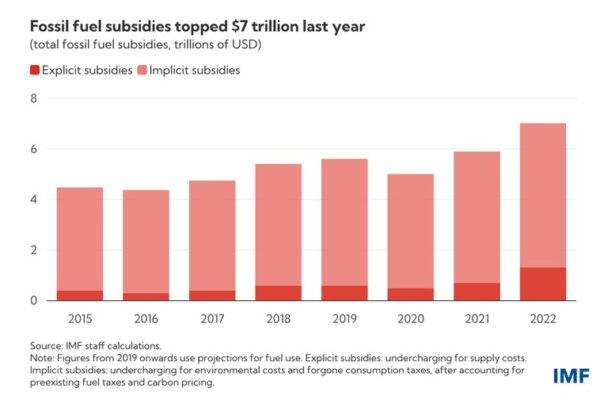
IMF: China leads as global fossil fuel subsidies hit record $7 trillion
Global fossil fuel subsidies hit a record U.S.$7 trillion, equivalent to more than 7% of global gross domestic product in 2022, the International Monetary Fund said. The subsidies are financial support from governments that make fossil fuels like oil, gas, and coal cheaper to produce or buy. Subsidies for coal, oil and natural gas in 2022 represented more than world governments spent on education and two-thirds of what was spent on healthcare. According to the IMF report released Thursday, governments provided support to consumers and businesses during the surge in global energy prices, a consequence of Russia’s incursion into Ukraine and the economic rebound from the COVID-19 pandemic. The IMF’s report comes as the world witnesses its highest average monthly temperatures on record. When burned, fossil fuels emit harmful pollutants that contribute to global warming and intensify extreme weather events. They also contaminate the air with toxins, harming our respiratory systems and other vital organs and killing millions yearly. By fuel product, undercharging for oil products accounted for nearly half the subsidies, coal another 30%, and natural gas almost 20% (underpricing for electricity accounts for the remainder), the report said. By region, East Asia and the Pacific accounted for nearly half the global subsidy, according to the IMF. Meanwhile, by country, in absolute terms, China contributed by far the most to total subsidies ($2.2 trillion) in 2022, followed by the United States ($760 billion), Russia ($420 billion), India ($350 billion), and the European Union ($310 billion). Graphic showing yearly global fossil fuel subsidies. Credit: IMF The bulk of global subsidies accounted for in the study fall into what the IMF termed implicit subsidies, which arise when governments do not adequately charge for the environmental damage caused by the combustion of fossil fuels. Such damage encompasses air pollution and climate change, with the impact forecast to grow due to the rising consumption of fossil fuels by developing countries. The IMF said explicit subsidies, in which consumers pay less than the supply costs of fossil fuels, have tripled since 2020, from $0.5 trillion to $1.5 trillion in 2022. The figure is similar to the estimates from the Canada-based think tank, International Institute for Sustainable Development, released Wednesday, that said the world’s biggest economies, the G20, provided a record $1.4 trillion in public money for fossil fuels in 2022 despite the promise to reduce spending. That includes investments by state-owned enterprises and loans from public finance institutions. The G20 nations, which cause 80% of global carbon emissions, pledged to phase out “inefficient” fossil fuel subsidies in 2009. Comprehensively reforming fossil fuel prices by removing explicit fuel subsidies and imposing corrective taxes such as a carbon tax would reduce global carbon dioxide emissions by 43% below “business as usual” levels in 2030 (34% below 2019 levels) the IMF said. It added that this would be in line with keeping global warming to ‘well below’ 2 degrees Celsius and towards 1.5 degrees Celsius. “Underpricing fossil fuels implies that governments forgo a valuable source of much-needed revenue and undermines distributional and poverty reduction objectives since most of the benefits from undercharging accrue to wealthier households,” the IMF report said. “The gap between efficient and current fuel prices is often substantial given, not least, the damages from climate change and the large number of people dying prematurely from fossil fuel air pollution exposure (4.5 million a year).” The IMF said fuel price reform would avert about 1.6 million premature deaths yearly from local air pollution by 2030. Edited by Mike Firn and Taejun Kang.

Wagner head plane crash provokes discussion in China
Russia’s civil aviation agency said Wagner Group head Yevgeny Prigozhin was on an airplane that crashed near Moscow Wednesday. It has fueled a wave of online discussion in China, where some drew comparisons to the Chinese Communist Party’s not so distant past. No cause for the crash was provided, but Wagner-flagged Telegram accounts blamed Russian air defenses for shooting down the Embraer jet. Prigozhin’s death comes exactly two months – to the day – after the Wagner Group undertook an armed rebellion against the Russian Armed Forces, seizing control of a Russian military office in the city of Rostov-on-Don and briefly marching on Moscow. According to the Wagner Group, Prigozhin was among 10 people who lost their lives in the crash involving a private plane flying from Moscow to St. Petersburg that came down less than half an hour after taking off. The group posted what is believed to be a video of the crash on social media platforms, showing an airplane crashing and burning. They confirmed that Prigozhin had died, describing him as a hero and a patriot. They further claimed that he died at the hands of “Russian traitors.” Eyewitness footage of the crash site of a plane linked to Wagner Chief Yevgeny Prigozhin, near Kuzhenkino, Tver region, Russia, August 23, 2023, in this screen grab taken from a video. Credit: Ostorozhno Novosti/Handout via Reuters Although the news broke in the middle of the night in China, keywords related to “Prigozhin” quickly trended on the social media app Weibo, which had 255 million daily users as of March of this year. Numerous bloggers also uploaded late-night videos discussing the implications of the Prigozhin incident. China’s earlier official response to Wagner Group’s brief mutiny was muted, with a Foreign Ministry statement on June 25 calling it “Russia’s internal affair,” adding that China “supports Russia in maintaining national stability.” But some experts interviewed by the state media outlet China Daily expressed concerns about the stability of China’s friend and neighbor. “The conflict between mercenaries and the Russian army is only the tip of the iceberg about the inherent contradictions in Russian society,” said Yu Sui, a professor at the China Center for Contemporary World Studies. Challenging the leadership Many online commentators remarked on the inherent risk of standing up to autocrats in what some of them dared to call “totalitarian” states. “Prigozhin, the head of the mercenaries, clearly didn’t understand politics. Didn’t he watch House of Cards? He made the mistake of rebelling against Putin,” blogger Yojia Fleet wrote. “Breaking news! Prigozhin’s private plane crashed north of Moscow. After offending Putin, he didn’t live long. As for the cause of his death, we can only speculate,” wrote another blogger who goes by the name of Wang Xiaodong Some Chinese netizens created polls such as “Who’s behind Prigozhin’s plane crash?” to attract attention and web traffic. Online comparisons were also made to the “Russian version of the Lin Biao incident,” a reference to a top leader of the Chinese Communist Party (CCP) and Chairman Mao Zedong’s chosen successor. In 1971, he is believed to have died when his plane nosedived into the grasslands of Outer Mongolia. China’s official line is that Lin planned to assassinate Mao and when his plot failed he tried to flee Beijing for Moscow, but with insufficient fuel to complete the flight. Russian President Vladimir Putin, right, and Chinese President Xi Jinping toast during their dinner in the Moscow Kremlin, Russia, March 21, 2023. CREDIT: Pavel Byrkin, Sputnik, Kremlin Pool Photo via AP, File Professor Yang Haiying of Japan’s Shizuoka University said the reason that online commentators were calling the incident the “Russian version of the Lin Biao incident” was because both China and Russia are dictatorships. “Chinese citizens are paying attention to this because of the close relationship between Xi and Putin. If anyone opposes Putin, their fate is sealed, just as if anyone opposes Xi, they might follow Lin Biao’s path,” said Yang. However, Hu Ping, honorary editor of the New York-based Beijing Spring magazine, said that the relationship between Prigozhin and Putin cannot be directly compared to that of Lin Biao and Mao Zedong. He added that Lin Biao’s accident was shocking all the same, and Prigozhin’s death was dramatic, sparking discussions online. “For the CCP, this isn’t politically sensitive because it’s an external event, but a dramatic one,” said Hu. “With the Chinese government supporting Russia in the war against Ukraine and Xi Jinping often comparing himself to Putin, these factors naturally lead to speculation.” Political commentator Wang Jian said that Chinese netizens were fascinated with the latest news because of China’s good relationship with Russia, but warned that government voices might use the news to make Chinese citizens even more afraid to challenge the government. “With issues like unemployment and dropping house prices, people are anxious,” said Wang. “The government is unpredictable. The focus of Chinese netizens on external events has decreased because of the economic downturn. But government online commentators might create an atmosphere that suggests disloyalty will lead to bad consequences.” Wang also alluded to the CCP’s complete grip on the military, saying it was unlikely that China could experience a mutiny similar to Russia’s. He added that Beijing won’t need to leverage the incident to strengthen control over the military. Edited by Mike Firn and Taejun Kang.
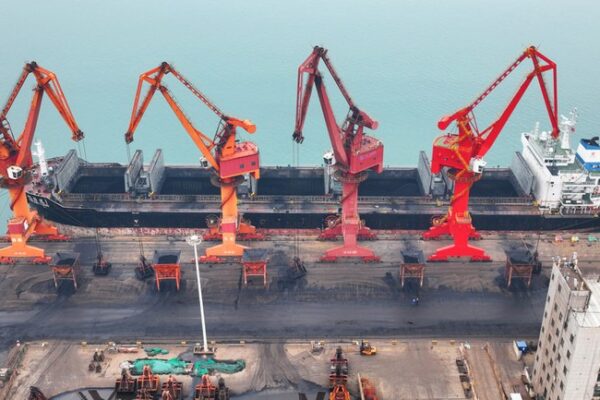
G20 spent a record $1.4 trillion on fossil fuels in 2022, report says
The world’s biggest economies, the G20, provided a record U.S.$1.4 trillion in public money for fossil fuels in 2022 despite the promise to reduce spending, a new study by a think tank said. “The 2022 energy price crisis, brought about by Russia’s invasion of Ukraine, has catapulted public financial support for fossil fuels to new levels,” said the International Institute for Sustainable Development, or IISD, in its analysis, Fanning the Flames, released on Wednesday. The amount is more than double the pre-pandemic and pre-energy crisis levels of 2019 and more than four times the annual average in the previous decade, the Canada-based organization said. When burned, fossil fuels emit harmful pollutants that contribute to global warming and intensify extreme weather events. They also contaminate the air with toxins, harming our respiratory systems and other vital organs and killing millions yearly. Of the funding, the largest share of $1 trillion was allocated as fossil fuel subsidies, while $322 billion was in the form of state-owned enterprise investments and an additional $50 billion as public financial institution loans. “While much of this was support for consumers, around one-third ($440 billion) was driving investment in new fossil fuel production,” the report said, adding such support “perpetuates the world’s reliance on fossil fuels, paving the way for yet more energy crises due to market volatility and geopolitical security risks.” “These figures are a stark reminder of the massive amounts of public money G20 governments continue to pour into fossil fuels – despite the increasingly devastating impacts of climate change,” said Tara Laan, a senior associate with the IISD and lead author of the study. The IISD said the increase in investment is against the expressed pledge in the 2015 Paris Agreement and such continued investments in fossil fuels greatly hinder the chances of meeting the climate targets, as they promote greenhouse gas emissions and diminish the cost-effectiveness of renewable energy. It said that G20 nations should redirect their financial investments from fossil fuels to targeted, sustainable support for social protection and the expansion of renewable energy. This aerial photo taken on Nov. 28, 2022 shows a cargo ship loaded with coal berthing at a port in Lianyungang, in China’s eastern Jiangsu province. Credit: AFP The report comes just ahead of the pivotal G20 leaders’ conference scheduled in New Delhi on Sept. 9-10, where discussions on climate change consensus are anticipated. The meeting could set the tone for the UN’s COP28 climate change conference in Dubai in November. The report lauded the achievement of G20 chair India as it reduced its fossil fuel subsidies by 76% from 2014 to 2022 while significantly increasing support for clean energy. The IISD urged G20 leaders to eliminate fossil fuel subsidies in developed nations by 2025 and in all other countries by 2030. The world leaders had agreed to phase out “inefficient” fossil fuel subsidies at the COP26 climate summit in Glasgow two years ago. “International public financing for fossil fuels has decreased in recent years but is still nearly four times greater than support for clean energy,” the report said, adding it came in the form of international aid, export credit support, and concessional financing, such as equity, grants, loans, and loan guarantees. China is among the top four largest providers of international public finance for fossil fuels in absolute dollar terms, providing $6.7 billion annually between 2019 and 2021. Japan provided $10.6 billion, while Canada provided $8.5 billion. South Korea came in third with a $7.3 billion investment. The most common fuels supported were oil and gas at 88%. The report also noted that G20 countries announced more than a quarter trillion dollars in subsidies for renewable power generation between 2020 and June 2023, with the United States, Germany and China leading the chart. “While positive, the renewable subsidies are dwarfed by subsidies for fossil fuels, which were over USD 1.4 trillion in the three years from 2020 to 2022,” the report said. The IISD also said while global investment in renewable energy reached a record high of $500 billion in 2022, it was still only around half of the investment in fossil fuels. Edited by Mike Firn and Taejun Kang.
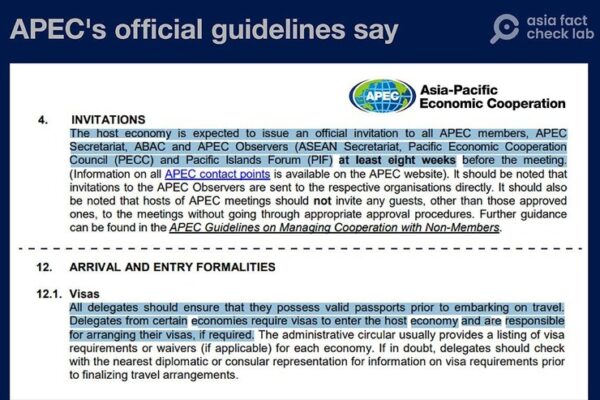
Will US break APEC rules if Hong Kong leader barred from summit?
Chinese authorities claimed that it would be a “violation of Asia-Pacific Economic Cooperation (APEC) rules” if the United States bars Hong Kong Chief Executive John Lee Ka-chiu from attending the APEC leaders summit in San Francisco in November. The claim came after media reports that Washington plans to prohibit Lee from attending the meeting of 21 regional economies. But the claim is misleading. APEC guidelines state visiting delegates are responsible for arranging their visas if they require them. The Hong Kong leader is under sanctions that bar his entry into the U.S. In a report published on July 27, The Washington Post cited unnamed White House officials as saying that the U.S. has decided to bar Lee from participating in the APEC Economic Leaders’ Meetings (AELM) to be held in San Francisco from Nov. 15 to 17, 2023. In response to the report, Chinese Foreign Ministry spokesperson Mao Ning said that refusing to invite Lee due to current U.S. sanctions against him was a mistake which “blatantly violates APEC rules and gravely contravenes the U.S. commitment as the host.” Lee currently cannot obtain any U.S. immigrant or non-immigrant visas due to an earlier U.S. presidential order and subsequent sanctions imposed on him and 10 other Hong Kong officials implicated in a 2020 government crackdown against democracy protestors. Hong Kong’s government pointed out in a separate statement that as the host of AELM, the U.S. had a basic responsibility to invite Hong Kong’s leader to the meeting. However the claim is misleading. Below is what AFCL discovered. Is the AELM host responsible for inviting the leaders of all APEC members? Yes. Article 4 of APEC’s guidelines for hosting meetings state that the host is supposed to send official invitations at least eight weeks in advance of the meeting, after deciding upon the meeting’s location and time. The guidelines also say: “APEC Leaders implicitly understand that they are invited to attend this meeting; the letter of invitation from the host economy’s leader is simply a formality.” But Matthew Goodman, a former National Security Council staff member who personally helped prepare for APEC meetings, told AFCL that APEC’s guidelines are neither related to international law nor legally binding. The explanation of rules concerning invitations and visa preparations for countries participating in APEC meetings. (Screenshots taken from APEC’s official website) Will invited representatives always be able to attend AELM? No. Section 12 of the guidelines states that all delegates invited to attend APEC meetings are responsible for arranging any required travel documents themselves. The section does not state that the host is required to issue them visas or waive policy or laws that would prohibit a person from entering its borders. “Given that the domestic laws of host countries must be respected, it isn’t right to claim that the U.S. is violating APEC’s rules,” Goodman says. What will happen to Lee? Unknown. A State Department spokesperson told AFCL that members of a foreign delegation must abide by U.S. laws and regulations when participating in APEC activities. “The U.S. will work with Russia and Hong Kong to ensure they participate in AELM ‘in an appropriate way’,” said the spokesperson without elaborating further. Russian President Vladimir Putin is in a similar situation to Lee as a result of U.S. sanctions put on him following the start of the Russo-Ukrainian war in 2022. This means Both Lee and Putin would need to secure a special visa waiver from the U.S. in order to attend this year’s AELM in San Francisco. The APEC Secretariat has not responded to inquiries about Hong Kong and Russian leaders as of press time. Meanwhile, a spokesperson from Hong Kong’s Chief Executive Office reiterated its earlier call on the U.S. to abide by APEC’s rules when inviting leaders to attend AELM. “Hong Kong will attend the APEC meeting in accordance with APEC rules, guidelines and practices,” the spokesperson told AFCL. APEC guidelines state that representatives can remotely attend AELM and other preparatory meetings leading up to the conference. Is there a history of a host refusing to invite APEC member economies to AELM? Yes – particularly in the case of APEC member Chinese Taipei, as Taiwan is referred to by the 21-member grouping. China strongly objects to Taiwan’s participation as it regards the island as part of China although Taiwan is self-governing. When China hosted AELM in 2001, it did not invite any Taiwanese representatives, despite then-Taiwanese President Chen Shui-bian’s expressed desire to attend in person. South Korea, the host of AELM in 2016, also refused to invite then-President of Taiwan’s Legislative Yuan Wang Jin-pyng to the meeting, requesting that Taiwan instead send an economic official rather than a political figure. Australia, which hosted AELM in 2007, rejected Tsai Ing-wen, who had just left her position as vice premier of Taiwan’s Executive Yuan, for similar reasons. Former Taiwanese President Chen Shui-bian expressed regret and dissatisfaction over China’s refusal to allow Taiwan’s delegates to attend the APEC meeting (Screenshot taken from the official website of Taiwan’s Office of the President) Translated by Shen Ke. Edited by Taejun Kang and Mat Pennington. Asia Fact Check Lab (AFCL) is a new branch of RFA established to counter disinformation in today’s complex media environment. Our journalists publish both daily and special reports that aim to sharpen and deepen our readers’ understanding of public issues.

Foreign diplomats in China treated to tour of Xinjiang and ‘happy’ Uyghurs
A Chinese government-sponsored visit to Xinjiang by 25 Beijing-based ambassadors and other diplomats from developing countries has come under fire by human rights activists for pushing an official narrative that the mostly Muslim Uyghurs in the far-western region are thriving, despite the reality of severe repression. The delegation, which included diplomats from Dominica, Myanmar, Iran, Kyrgyzstan, Uzbekistan, Pakistan, Nicaragua and Mexico, visited the western autonomous region from July 31 to Aug. 3. Xinhua news agency and CGTN, China’s state-run international TV broadcaster, covered the diplomats as they visited Xinjiang’s capital Urumqi, the cities of Aksu and Kashgar, and other significant locales to observe the region’s “economic and social progress” and affirm that “the local population in Xinjiang is living a happy life.” And the Chinese government’s efforts appear to have paid off. “During our time in Xinjiang, we had open conversations with the local people and observed that they lead content and happy lives,” Martin Charles, the ambassador to China from the small Caribbean island nation of Dominica, told Xinhua. “We didn’t come across any instances of forced labor, and there were no indications of human rights violations,” he said. China is relying on government-organized visits for foreign officials and influential people from various professions to promote an alternative vision of Uyghur life in Xinjiang amid growing condemnation by Western nations over its maltreatment of Uyghurs and other Turkic minorities. The U.S. government and several Western parliaments have declared that the ongoing human rights abuses, including arbitrary detentions, torture, forced sterilizations of Uyghur women, and forced labor, amount to genocide and crimes against humanity. China has also denounced a report issued nearly a year ago by the U.N. high commissioner for human rights that documented cases of severe rights abuses in Xinjiang. The report said that the abuses could constitute international crimes, in particular crimes against humanity. Though the groups invited to tour the region are diverse, they have one thing in common: They all support China’s “Xinjiang policy.” ‘Telling the story of Xinjiang well’ In early February, another visiting delegation of Beijing-based ambassadors and diplomats from African countries, including Senegal, Benin, Mali, Rwanda, Madagascar, Malawi, Uganda, Lesotho and Chad, visited Xinjiang and expressed support for China’s policies there. All the countries maintain strong economic ties with China because many have benefited from Chinese-built and financed infrastructure projects under the Belt and Road Initiative. They also support China within the United Nations. Members of the delegation of diplomats who visited in July also expressed their rejection of a previous proposal by the U.N.’s top human rights body to hold debate on alleged rights abuses against Uyghurs and other ethnic minorities in Xinjiang. The proposal by mostly Western nations, including the United States, was voted down in October 2022. Six days before the diplomats visited Xinjiang, the Chinese government organized a seminar in Urumqi to convey its narrative of the region. During discussions about “telling the story of Xinjiang well,” participants emphasized reaching overseas audiences by transmitting the narrative in languages other than Mandarin Chinese. Hector Dorbecker, counselor for economic-commercial and financial affairs at the Embassy of Mexico in Beijing, tries to play dutar, a long-necked two-stringed lute, in Jiayi village of Xinhe county, northwest China’s Xinjiang Uygur Autonomous Region, Aug. 2, 2023. Credit: Zhao Chenjie/Xinhua via Getty Images In late December 2018, a delegation of diplomats from Kazakhstan, Russia, Kyrgyzstan, Malaysia, and 12 other countries, all stationed in Beijing, visited Xinjiang on an agenda organized by the Chinese government, which presented “re-education” camps as voluntary vocational training centers. The Chinese government has also sponsored foreign journalists on trips to Xinjiang. Chinese officials arranged for a group of journalists from 10 foreign media outlets to tour major cities in Xinjiang in April 2021 to defend its policies in the region and dispel reports of human rights abuses. In August 2019, Chinese Communist Party officials hosted another group of foreign journalists, most of whom worked for state broadcasters from countries along the Silk Road economic belt, putting them up in fancy hotels while they toured Xinjiang and lecturing them on China’s measures to stop terrorism and separatism in the region. The officials took the journalists to some mosques still left standing though authorities had closed, demolished, or turned into museums many others in Xinjiang, to a “re-education” camp they said was a vocational training center, and to shows where young Uyghurs danced and sang. rights activists weigh in Henryk Szadziewski, director of research at the Uyghur Human Rights Project, said the arranged visits are “a consistent tactic employed by the Chinese government to conceal their wrongdoings” during which they use others to amplify their messages. “Whether it is a western vlogger doing a travel blog or diplomats from countries that are friendly, or that rely on China in terms of its economy, or [face] threats or pressure, they put out this message that Xinjiang is now safe and prosperous as a region,” he said. While China invites people from nations sympathetic to its perspective to visit Xinjiang, it has rejected requests by the U.S. and human rights groups that independent investigators be able to visit the region. Sophie Richardson, China director at Human Rights Watch, said all visits to Xinjiang by foreign diplomats were designed by China to cover up rights abuses. “If everything is fine, why not let in independent international investigators, particularly given the mountain of evidence of some of the most serious crimes under international law?” she asked. “So, it’s not clear why some people got to go and others don’t unless Beijing has something to hide,” she said. Sayragul Sauytbay, an ethnic Kazakh who testified about the abuse she witnessed while detained in a “re-education” camp in Xinjiang, cautioned visiting diplomats against ignoring China’s rights abuses in the region and becoming accomplices to them. “They know and can see China is lying, but they are turning a blind eye,” she said. “These are the countries that rely on China, but for them, this is a rare opportunity….

Did US falsify medal tally in the 2023 World Aquatics Championships?
A screenshot taken from a broadcast of the 2023 World Aquatics Championships has been repeatedly shared in Chinese-language social media posts that claim it shows U.S. media had falsified the country’s final rank in the international championships. But the claim is false. The screenshot only shows partial results for the swimming match – one of the competition’s six disciplines, not the final ones for all events, where China ended with the most gold medals. A tweet posted by a user @ChanJoe18 on July 29 reads: “Rigging the standings, falsifying the rankings: U.S. ranks first with 3 gold medals, China only ranks third with 20 gold medals.” The claim was accompanied by a screenshot of a medal table of the 2023 World Aquatics Championships, which shows the U.S. ranked first, Australia second and China third by total medals. The same screenshot alongside similar claims has also been shared in Chinese-language social media posts as well as state media reports in China and Russia. The international championships were held in Fukuoka, Japan, between July 14 and 30, 2023, with a total of 75 medals awarded across six disciplines: swimming, artistic swimming, open water swimming, diving, high diving, and water polo. Although it’s a subject of debate whether nations should be ranked by total medals won, rather than gold medals won, there was no factual error in the screenshot, which was misrepresented in these social posts. So the claim is false. A widely circulated post on Chinese social media claimed that U.S. media falsified the results of the 2023 World Aquatics Championships, with Chinese and Russian official media soon claiming the U.S. was “fooling itself.” (Screenshots taken from Twitter and Weibo) Origin of screenshot Through keyword searches, AFCL found the identical screenshot published on July 28 in a tweet by the founder of swimming news outlet SwimSwam, Braden Keith. A logo and text included in the screenshot show that it was taken from a broadcast of the competition on the NBC streaming platform Peacock. NBC is the oldest of the three major traditional American television networks and covers major sporting events. “Today, NBC and USA Swimming officially waived (sic) the white flag at the end of finals by changing their medals table graphic to a total medals sort,” said Keith, pointing out the broadcaster’s move to rank nations by total medals won rather than by gold medals won. Some netizens joined him in mocking how the medals tally was presented. According to the medals table in the screenshot, the U.S. leads the tally with a total of 25 medals, despite earning fewer gold medals than Australia and China. Braden Keith, editor-in-chief of a swimming news outlet SwimSwam, posted the tweet which contained the screenshot later spread by Chinese netizens. (Screenshot taken from Twitter) Not final results AFCL found that the screenshot only displayed results from the first six days of the nine-day swimming match at the championships, and is clearly marked as such. The medal counts depicted in the screenshot correspond to the official tally between July 22 and July 27. The championships concluded on July 30 with China leading the medal tally in all disciplines with 20 gold medals followed by Australia and the U.S. in second and third place, respectively. Translated by Shen Ke. Edited by Taejun Kang and Mat Pennington. Asia Fact Check Lab (AFCL) is a new branch of RFA established to counter disinformation in today’s complex media environment. Our journalists publish both daily and special reports that aim to sharpen and deepen our readers’ understanding of public issues.

